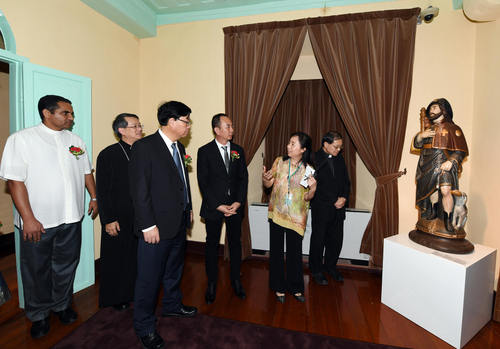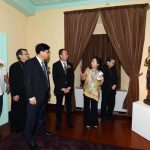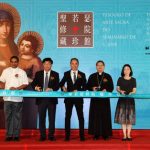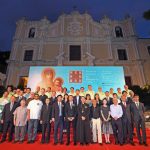 Guests visited the “Treasure of Sacred Art of St. Joseph’s Seminary”.
Guests visited the “Treasure of Sacred Art of St. Joseph’s Seminary”.
In order to allow the public to have better understanding of the St. Joseph’s Seminary and the history of the development of the Catholicism in Macao, as well as to appreciate the Seminary’s valuable collections, the Cultural Affairs Bureau (IC) has worked with the St. Joseph’s Seminary and the Diocese de Macau to establish the “Treasure of Sacred Art of St. Joseph’s Seminary” at the St. Joseph’s Seminary, which was officially inaugurated today (7 October) at 6pm. The opening ceremony was officiated by the President of the Cultural Affairs Bureau, Ung Vai Meng; the Deputy Commissioner of the Ministry of Foreign Affairs of the People’s Republic of China in the Macao SAR, Cai Siping; the Bishop of Diocese de Macau, Stephen Lee Bun Sang; Priest of St. Joseph’s Seminary, Jojo Peter Ancheril; and the Head of the Department of Exhibitions and Museums of the Cultural Affairs Bureau, Lei Lai Kio. Prior to the opening ceremony, the Sanctus Thomas Choir of the St. Joseph’s Seminary Choir presented a series of sacred music performance. On inauguration day, 8 October, admission to the “Treasure of Sacred Art of St. Joseph’s Seminary” was free and was open to residents and tourists. St. Joseph’s Seminary is located at St. Augustine’s Square. In 2001, the seminary received the UNESCO Asia-Pacific Awards for Cultural Heritage Conservation, and became one of the designated sites of the Historic Centre of Macao in 2005 and was inscribed in the World Heritage list. It has became an important part of the Historic Centre of Macao. In 1728 the Jesuits founded the St. Joseph’s Seminary, which became an important base for Catholic training. Built in 1758, the adjacent church became the second higher education institution of the Jesuits for educating missionaries in Macao, where the complex was commonly known as “Sam Pa Chai” among the local population. From 1762, the Seminary went through several hands and vicissitudes, returning only to the management of the Jesuits in 1930. This historical seminary is closely connected to the evolution of Macao’s society and it has greatly contributed to the city’s culture, education, art and charitable endeavours. St. Joseph’s Seminary had been the second and third site of Colégio Diocesano de Sao José, with several religious relics, such as ancient books, oil paintings, statues and ritual supplies collected. In order to allow the public to appreciate these valuable historical collections, the Cultural Affairs Bureau has worked with the St. Joseph’s Seminary and the Diocese de Macau to establish the “Treasure of Sacred Art of St. Joseph’s Seminary”, featuring nearly 110 valuable items and sets. Residents and tourists can learn more about the history of the Seminary and the history of the Catholicism in Macao, as well as the history of cultural exchanges between China and the West after their visit to the Museum. In response to this initiative, the organizer also host two lectures on 8 October, at 10am and 11:30pm, at the St. Joseph’s Seminary. The first lecture, titled “The First University of the Far East in Macau : The Commitment of the Jesuits to Higher Education in Asia”, is conducted by the Director of the Macau Ricci Institute, Stephan Rothlin, S.J.,; while the second lecture, titled “Contributions of St. Joseph’s Seminary on Music in the 20th Century”, is conducted by the Professor of the School of Arts of the Macao Polytechnic Institute, Dai Dingcheng,. The “Treasure of Sacred Art of St. Joseph’s Seminary” is open daily from 10am to 5pm (closed on Wednesdays). Admission is free. From 22nd October onwards, guided tours in Cantonese are available to the public every Saturday and Sunday, from 3pm to 4pm. For more information, please call through tel. no. 2835 7911, during office hours.
View gallery



